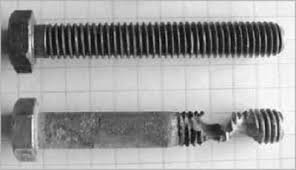Dougcole
Guru
While cleaning my engine room today I found the below sheered off bolt under my dripless seal on the Stb side. A little investigation led me to see that it came out of the shaft flange, sheered off clean.
All three other bolts in the flange appear to be fine. Our last trip was a long one, 120 miles non stop at fast cruise, the boat ran great, no vibration or anything. I haven't hit anything recently, at least to my knowledge. I was under the boat a lot in the last few weeks (we were in the Bahamas) and the props are fine.
Any idea what could make the bolt sheer off like this?
Crevice corrosion maybe?
All three other bolts in the flange appear to be fine. Our last trip was a long one, 120 miles non stop at fast cruise, the boat ran great, no vibration or anything. I haven't hit anything recently, at least to my knowledge. I was under the boat a lot in the last few weeks (we were in the Bahamas) and the props are fine.
Any idea what could make the bolt sheer off like this?
Crevice corrosion maybe?


